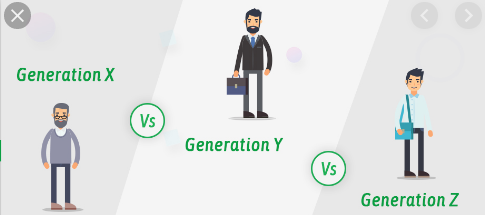Creating a customer … sounds pretty basic, doesn’t it? It is equally or more important to create customers that create customers. In both instances, the process begins with knowing your customers well. And the customer generations help.

That goes without saying, doesn’t it? Segmentation targeting by generational differences can be of particular significance in this regard.
The purpose of a business is to create a customer.
–Peter Drucker
Currently, the demographics of customers span five generations. These generations are the Mature/World War II Generation, Baby Boomers, Generation X, Generation Y/Millennials, and generation Z.
In addition to the many differences among individuals within generational cohorts, businesses must contend with different preferences between generations. And to accomplish this they must know and apply these generation preferences. Let’s take a look at these generations and their preferences.
The Five Generations in the United States and Canada in the Workforce
- Silent generation (1923 – 1944)
- Baby Boomers (1945 – 1964)
- Generation X (1965 – 1980)
- Generation Y/Millennials (1981 – 2000)
- Generation Z (1995-2015)
These generation labels are primarily used in the United States and Canada. Other regions throughout the world use some of these labels, though the ages of their members of these groups tend to differ.
Mature/World War II Generation … The Silent Generation
Veterans (WWII Generation) or also known as the Silent Generation – Born before 1944
Significant Influences
- Great Depression, the New Deal, WWII, the G.I. Bill, Pearl Harbor
Characteristics
- Patriotic, loyal, fiscally conservative, faith in institutions
The silent generation came of age in the years following the Great Depression and WWII. To understand this generation, think “American Values” – civic pride, loyalty and respect for authority.
They attend more symphonies than rock concerts, watch more plays than pick-up softball, and eat more steak than tofu. At work, they are the classic “keepers of the grail” and an irreplaceable repository of lore and wisdom.
Members of this generation are 70 years or older. Although most members have retired from the labor force, they comprise a wealth of valuable knowledge and experience. We believe this generation views work as an obligation: they respect authority and tend to take rational approaches to shop.
When Communicating with the Silent Generation
Acknowledge their experience
Use good grammar and clear pronunciation
Link your message to company history
Baby Boomers – Born 1945 to 1964
Significant Influences
Economic prosperity and recession, expansion of suburbia, television, Vietnam, Watergate, protests and human rights movements, sex, drugs, and rock ‘n’ roll

Characteristics
Idealistic, competitive, question authority, desire to put their own stamp on things, challenge institutions
Boomers grew up in the post-WWII era when the economy was the healthiest the country has ever known. Parents and teachers taught them, “You can be anything you want to be, including President of the U.S.” They turned the organizational hierarchy on its head, revolutionized the workplace, and devoted themselves to 60-hour workweeks.
Baby Boomers are approximately between the ages of 45 and 64. The older members have begun to retire from the labor force. This generation occupies most of the senior-level management roles. They are often stereotyped as extremely focused on work, and they possess a strong work ethic.
When Communicating with Boomers
Take time to establish rapport
Link your message to company vision and values
Acknowledge their work ethic
Generation X (Gen-Xers) – Born 1964 to 1981
Significant Influences
Sesame Street, MTV, the Game Boy, the personal computer, divorce, AIDS, crack cocaine, missing children on milk cartons and missing parents at home.
Characteristics
Eclectic, resourceful, self-reliant, distrust of institutions, highly adaptive to both change and technology.
Gen-Xers grew up amidst corporate layoffs, recession, inflation, and the Watergate hearings. Technologically adept, they want more fun and flexible workplace. They complain their older co-workers “live to work” while they simply “work to live.”
Generation=Xers are approximately between the ages of 33 and 53. The oldest members could be entering senior-level management roles while the younger members are pursuing mid-career supervisory roles. Many members of Generation X embrace diversity, technology, and entrepreneurship.
When Communicating with Gen-Xers
Get to the point
Avoid buzzwords, cliché, and hyperbole
Lighten up
Nexters (Generation Y / Millennials) – Born 1980 to 2000
Significant Influences
Fall of the Berlin Wall, expansion of technology and the media, a mixed economy, natural disasters, violence, drugs, and gangs.

Characteristics
Globally concerned, integrated, realistic, pragmatic, cyber literate, media-savvy, and environmentally conscious
Millennials are coming of age in an era in which it’s once again popular to be a child. Digital in diapers, they see the world as connected, global, and round-the-clock. Although they’ve only begun to arrive in the workplace, and they are still “works-in-progress”, it appears they may be new-fangled versions of their WWII grandparents and great-grandparents.
Generation Y or Millennials are approximately between the ages of 19 and 39. The older members are in the labor force while the younger members are still completing their formal education. This generation is known for being optimistic and goal-oriented: they are known for enjoying collaboration and multitasking, are comfortable embracing emerging technologies, and appreciate meaningful work.
When Communicating with Nexters
Be positive
Be open to their ideas
Generation Z – Born after 2000
Weaned on smartphones, these kids are the first true digital natives. For many families, this gadget-savvy group that is up on most things Web is the go-to source for information. This gives Gen Z significant influence over household purchasing decisions and behaviors.
This generation is also more brand aware than any before it. Note, a child of this generation can recognize almost 100 brands by age 3.
The bottom line
It is critical for businesses to segment their customers by generations. Learn about and talk through generational issues so as to assist in building customer relationships.
In engaging customers, acknowledge and appreciate differences. In moving forward, continue to develop your knowledge of each generation’s preferences.
So what’s the conclusion? The conclusion is there is no conclusion. There is only the next step. And that next step is completely up to you.
It’s up to you to keep improving your customer attention and focus. Lessons are all around you. In many situations, your competitor may be providing ideas and or inspiration. But the key is in knowing that it is within you already.
